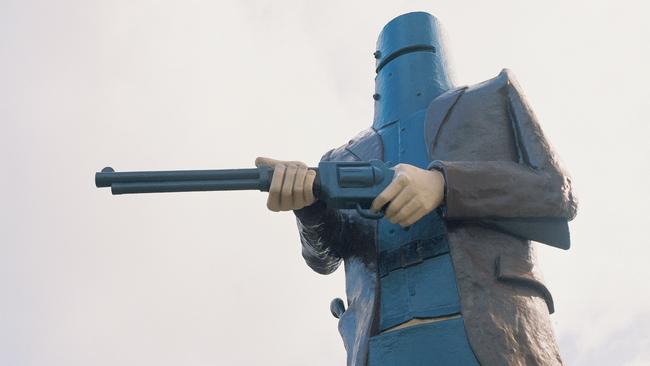The Politics of Myth: a study of Ned Kelly and other popular legends
Popular legends have been reimagined to reflect shifting beliefs, aesthetic tastes and social preoccupations.

The myths that underpin culture are what each generation makes of them. According to Stephen Knight, who has devoted a long academic career in Australia and Britain to the study of popular mythology, myths “seem both distant and ethereal by not being bluntly realistic, but at the same time ... are insistently present, and provide ways of thinking about the structures, values and human roles within societies that live by and realise themselves through that culture”.
The Politics of Myth is a Cook’s tour of the centuries of mythmaking that has bequeathed us enduring, if elusive characters such as King Arthur, Queen Guinevere, Merlin, Robin Hood, Queen Elizabeth I, William Shakespeare, Jeanne d’Arc, Ned Kelly and Sherlock Holmes. Each of these figures has meant different things at various times to people across the world.
Each myth has been reimagined to reflect shifting beliefs, aesthetic tastes and social preoccupations. In particular, Knight emphasises, the representation of females with mythic status in the West has undergone substantial revision as old stereotypes have been challenged and overturned, especially in representations by female writers and filmmakers.
Queens such as Elizabeth and Guinevere have been subject to a process of re-evaluation that has led to new and clearer visions of their strength and complexity. Jeanne d’Arc, meanwhile, stimulates the modern imagination as much for her seemingly androgynous attitude towards her appearance and her astonishing physical courage as for her religious zeal. In her time, Jeanne was considered too much of a political threat to be allowed to live, so she was burned at the stake.
Even with modern reinterpretation, the more things change in popular mythology the more to an appreciable extent it seems they stay the same. “The recent force of feminism”, writes Knight, “has displaced Robin and Arthur from their positions of unquestioned masculine authority, though it has not made anything like heroes out of Guinevere, Jeanne and Elizabeth, the women mythic figures who mix triumph with the problems generated by their combination or power and gender”.
According to Knight, apart from the question of gender the myths that are most pervasive are those such as Robin Hood and King Arthur, based on characters that never existed as far as anyone knows. Both Robin Hood and King Arthur can be represented as egalitarian as well as authoritarian heroes who are as modern or anachronistic in their outlook as we wish them to be. Without any kind of historical evidence for their life or death, no one can ever say for sure which is the ‘‘real’’ Robin or Arthur.
By contrast, a figure such as Ned Kelly — who did definitely have a historical existence — is the subject of a fierce and ongoing debate as to whether he was a hero or villain, or a mixture of both, an argument never likely to be settled. Similarly, there continues to be controversy over whether Shakespeare, a real person, could have written all those plays — a ridiculous debate, in Knight’s view.
Meanwhile, a fictional character such as Sherlock Holmes can become so powerful that even its own creator can no longer control it. Arthur Conan Doyle famously wanted to kill off Holmes after an initial run of adventures in order to focus on literary projects that he considered more important, but his enthralled readers would not allow the great detective to die. Part of the mythology of Holmes are features, such as certain attributed sayings and the signature deerstalker hat, that Conan Doyle did not have anything to do with. Evil genius Professor Moriarty hardly ever appeared in the original stories, and yet has taken on a kind of mythic status almost commensurate with that of the great detective himself. Similarly, Irene Adler, a strong female character who appears fleetingly in the original Holmes fiction, now has a life of her own in popular culture.
Knight’s survey is confined to popular myths that were generated before the start of the 20th century. While the oldest myths in our culture have been around for millennia, they are constantly being reworked. Perhaps Harry Potter, like Sherlock Holmes, in some distant sense is a version of Merlin, while James Bond is a sort of British imperial lone warrior harking back to the Knights of the Round Table. So many of the most powerful myths of our own time come from the US in the form of comic-book superheroes, the cowboys of the old west or from space operas such as Star Wars.
The Politics of Myth will be welcomed by anyone interested in the history and development of our culture. Each of us has been affected by the popular myths discussed in this book, whether we realise it or not.
Simon Caterson is the author of Hoax Nation: Australian Fakes and Frauds from Plato to Norma Khouri.
The Politics of Myth
By Stephen Knight
MUP, 264pp, $32.99



To join the conversation, please log in. Don't have an account? Register
Join the conversation, you are commenting as Logout